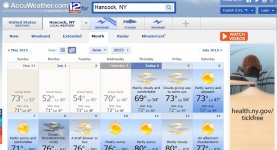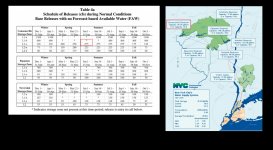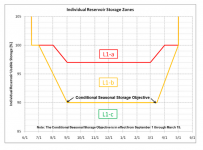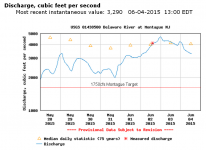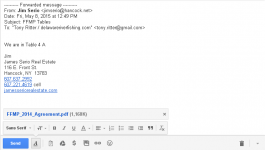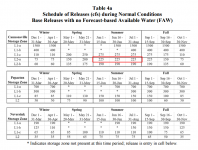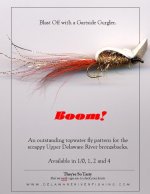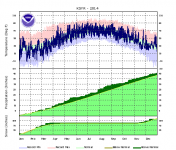TR
"You can observe a lot just by watching." Y. Berra
Published in this week's River Reporter:
http://www.riverreporter.com/my-view/4302/2015/06/03/upper-delaware-river-taking-heat-again
http://www.riverreporter.com/my-view/4302/2015/06/03/upper-delaware-river-taking-heat-again
By Theresa Allen, Jim Costolnick and Sam Rowe
For the second time this season, warming temperatures are threatening the Upper Delaware River watershed.
Very low river flows and high daytime and nighttime air temperatures will likely pose serious threats to the
health of the world-class cold-water ecosystem that defines this region.
Local businesses that rely on the short recreational season to carry them through the year are experiencing another slowdown in commerce and are searching for solutions. Their primary focus is the management of the New York City Delaware Basin reservoirs and the availability of reserve water that could be released to the river to protect habitat and recreational opportunities.
When the water level gets too low, people can’t use the river and companies in towns like
Hancock, NY, lose business. And that business is often lost forever, which includes state tax dollar revenues.
It is astounding that the authorities who control the reservoirs are not able to give us just a little bit of water to protect our river and our community.
The City of New York along with the states of New York, New Jersey, Delaware and Pennsylvania have
the authority to approve additional water releases from the Delaware reservoirs, and there are reserve supplies that were created for situations where downstream areas need relief from stressful conditions like the one facing the Upper Delaware River this week.
Guides have already cancelled guided trips this week because their clients are looking at their iPhones
and seeing hot temperatures and low water releases in the river in recent weeks. Their livelihood depends on this river, and it is hard to understand how the state and the City of New York can turn a blind eye to the situation in our area time and time again.
Jeff Bump, co-owner of Paddle and Pedal Outdoors, a canoe, kayak, and bike rental business based in Hancock, commented on the lack of recreational traffic as a result of low water levels on the Upper Delaware system. “Plain and simple, people want to float along, not drag their canoes and kayaks over exposed gravel and low water areas of the river. It does not make for an enjoyable, relaxing day on the water.”
The Upper Delaware River region struggles to reinvent itself economically and increasingly looks to the river as a resource upon which to build its future. But unreliable water releases from the reservoirs threaten to stymie that effort, leading to confusion among community leaders.
The river is a very important economic asset for the Town of Hancock and its neighbors, and we need it to be as healthy as possible.
When boats bottom out because of low flows and fishermen stay home because of high water temperatures, the towns suffer.
All we’re asking for is a little bit of water during these stressful situations. It absolutely astounds me that we can’t figure out a way to get this done.”
[Theresa Allen is the owner/operator of Hancock Liquor Store; Jim Costolnick owns the Border Water Outfitters and Fly Shop, and Sam Rowe is the Hancock town supervisor.]
http://www.riverreporter.com/my-view/4302/2015/06/03/upper-delaware-river-taking-heat-again
http://www.riverreporter.com/my-view/4302/2015/06/03/upper-delaware-river-taking-heat-again
By Theresa Allen, Jim Costolnick and Sam Rowe
For the second time this season, warming temperatures are threatening the Upper Delaware River watershed.
Very low river flows and high daytime and nighttime air temperatures will likely pose serious threats to the
health of the world-class cold-water ecosystem that defines this region.
Local businesses that rely on the short recreational season to carry them through the year are experiencing another slowdown in commerce and are searching for solutions. Their primary focus is the management of the New York City Delaware Basin reservoirs and the availability of reserve water that could be released to the river to protect habitat and recreational opportunities.
When the water level gets too low, people can’t use the river and companies in towns like
Hancock, NY, lose business. And that business is often lost forever, which includes state tax dollar revenues.
It is astounding that the authorities who control the reservoirs are not able to give us just a little bit of water to protect our river and our community.
The City of New York along with the states of New York, New Jersey, Delaware and Pennsylvania have
the authority to approve additional water releases from the Delaware reservoirs, and there are reserve supplies that were created for situations where downstream areas need relief from stressful conditions like the one facing the Upper Delaware River this week.
Guides have already cancelled guided trips this week because their clients are looking at their iPhones
and seeing hot temperatures and low water releases in the river in recent weeks. Their livelihood depends on this river, and it is hard to understand how the state and the City of New York can turn a blind eye to the situation in our area time and time again.
Jeff Bump, co-owner of Paddle and Pedal Outdoors, a canoe, kayak, and bike rental business based in Hancock, commented on the lack of recreational traffic as a result of low water levels on the Upper Delaware system. “Plain and simple, people want to float along, not drag their canoes and kayaks over exposed gravel and low water areas of the river. It does not make for an enjoyable, relaxing day on the water.”
The Upper Delaware River region struggles to reinvent itself economically and increasingly looks to the river as a resource upon which to build its future. But unreliable water releases from the reservoirs threaten to stymie that effort, leading to confusion among community leaders.
The river is a very important economic asset for the Town of Hancock and its neighbors, and we need it to be as healthy as possible.
When boats bottom out because of low flows and fishermen stay home because of high water temperatures, the towns suffer.
All we’re asking for is a little bit of water during these stressful situations. It absolutely astounds me that we can’t figure out a way to get this done.”
[Theresa Allen is the owner/operator of Hancock Liquor Store; Jim Costolnick owns the Border Water Outfitters and Fly Shop, and Sam Rowe is the Hancock town supervisor.]

